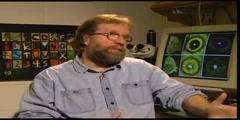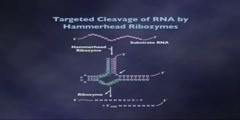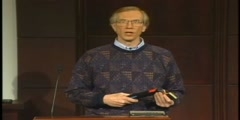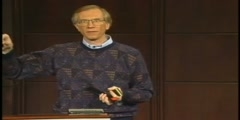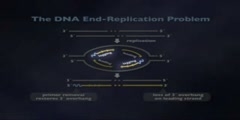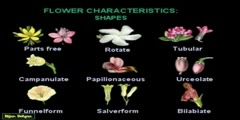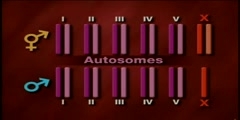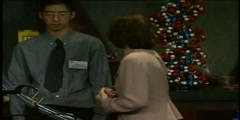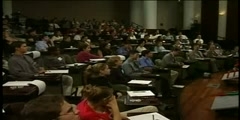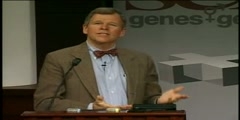The Biosphere Lecture MIT Prof. Penny Chisholm
Biology > Introductory Biology Email this pageVideo Lectures - Lecture 16/nTopics covered: The Biosphere Instructor: Prof. Penny Chisholm Transcript - Lecture 16/nSo my name is Penny Chisholm and I am a professor in the Department of Civil and Environmental Engineering with a joint appointment in biology and I'm a microbial ecologist. I'm an ecologist by training and I work on microbes in the oceans, photosynthetic plants in the oceans. They're called phytoplankton. That's the research that my lab does. Whenever I'm using examples in here, a lot of times I'll be using examples of microbes and of plants in the oceans./nI know most people know a lot more about trees than they know about things that photosynthesize in the oceans. And I'll convince you that you should be as bonded to phytoplankton as you are to trees in terms of recognizing your dependency on them. So that's just a little bit about my background. Now, let me find out a little bit about you. Is there anyone in here who has taken the ecology class 7./n30 or 1.018 that I used to teach but haven't taught for the last two years? No. Well, that's good because there's some redundancy. And are there any Terrascope students or alums in here? OK. Just curious. So let me tell you just briefly about my hopes for our interactions in this class, and I stress the term interaction. I don't want to stand up here talking at you./nI really hope that you will ask questions and interact with me. It makes it much more interesting for us up here if people are asking questions and challenging. I expect you to challenge what I say. The field of ecology is very broad. It uses knowledge from physics, from chemistry, from geology, all these diverse fields, and biology of course. And so some of the things I'm going to talk about, I know there are students here who know more about it than I do because I think you all are majoring in very diverse majors at MIT./nSo I expect that if I'm saying something wrong that you challenge me because we're all in this together. The goal is to learn, not necessarily to be right all the time. OK. So what I'm going to do today is really to give you a broad overview of the field of ecology. And the things that I'll talk about are things that we're going to go into in depth in the next series of whatever lectures I have, ten or eleven./nSo most of this you don't need to take any detailed notes on or whatever. This is just to forecast what's to come. At the end I'll tell you what the important points are. So what is ecology? It's a very broad field and it's basically the study of the interaction between organisms and their environment. Or the study of what regulates the distribution and abundance of organisms./nAnd what we're going to do is talk about the subdivisions of ecology and look at the characteristics of ecological systems, define some general characteristics and then we'll begin to talk about ways that life mediates the transformation of energy and mass on Earth. So in this class I'm going to be talking about all levels of organization of living systems from the biochemical level, the gene level to the entire biosphere, no small challenge./nSo the discipline of ecology, I'm going to move this down a little bit, is only about a hundred years old. It's a relatively new discipline but it's a strict natural science. Ecology is not environmentalism. Ecology is not recycling. Ecology is a branch of the biological sciences. And it uses the Scientific Method which I know you're all familiar with./nBut let's just review how ecologists learn about how systems work. And it starts with observation. Sometimes called descriptive. You go out and you describe what you see in nature. So description. And from that you form a hypothesis about the things that are structuring that system. And then you actually do experiments. And this is something that a lot of people don't realize. We can do experiments with ecological systems, be they microsystems, or some of the things we'll talk about in this class are experiments with whole ecosystems./nFor example, they'll clear-cut an entire forest watershed and compare then the behavior of the elements cycling in that watershed with a control watershed where you don't clear-cut the trees. So it's a basic experiment, just like you would do in test tubes. And there are numerous other examples about manipulating whole ecosystems, fertilizing whole lakes. Obviously, it's more difficult because you have to get permission to do these kinds of things and have hundreds of replicates of these experiments, but it is a way of understanding the systems./nAnd then from the experimental results you test the hypothesis and then you develop models of how the system works. And then you revise your description based on the models. And then you keep going through that cycle. Ecology. At many universities you can get a PhD in ecology. They have whole departments of ecology. We at MIT don't./nWe have very few people even who are ecologists, but it is a field and you can go onto get a PhD. OK. So what are the subdisciplines of ecology? And it has to do with the hierarchical organization of living systems. Let me go onto my first slide here. And I have a pointer. Oh, well. I have to stand back. So when we think of living systems you can start with the atom. And together they come together and make up molecules, come together and make up the cell./nAnd then the cells come together and make up tissues and organs, and then eventually you have an organism. Although, you can have unicellular organisms. Here's an organism. And then a group of organisms belonging to the same species is called a population in ecology. And there's a whole field called population ecology. We'll have a few lectures on that where you study what regulates the growth and the life cycles of a particular species of organism./nAnd then a collection of populations is called a community. And there's a whole field called community ecology. And then a collection of communities. This is a coral reef. Can you guys see these slides in the back or is there too much light? Is it OK? OK. Good. So this would be a coral reef ecosystem. And then all of the ecosystems collectively on Earth constitute the biosphere./nSo ecologists study these systems at different levels of organization depending on what questions they're interested in. But of course this is a gross oversimplification of what we know about living systems. For example, an organism. I mean is an organism really an organism? Think of yourself, for example. Are you only one species? You're a human, yes. But there are parts of you that aren't human, right? What's in your gut? E./ncoli. There are more bacteria in your gut than there are human cells in your body. And without those bacteria you'd be in trouble. Also your skin is an ecosystem. It's teaming with mites and little creatures that if you looked under the microscope you'd be appalled. All of your pores have tiny little ecosystems in them. And most of these are doing their job. You're their habitat. And they're helping you be a living being./nSo you yourself are an ecosystem. So it's really difficult to talk about these in a very clean way. I mean you cannot really study an organism all by itself because each organism is in itself an ecosystem or a community. Maybe not an ecosystem but a community of organisms. But this is the way we have come to divide up the living world at different levels of organization./nAnd we will talk about all of these in this class. So ecology really has two broad branches. And that's how my series of lectures are divided up. One is called biogeochemistry. And in this branch is the study of how organisms mediate the transformation of energy and matter in the biosphere. And this is essentially talking about the metabolism of ecosystems. In some ways we will talk about, you've been learning all about the biochemistry of cells and how cells work and how they process energy, etc./nThe sum of all of that biochemistry in cells results in these biogeochemical cycles, the interactions between these organisms and their environment. When we talk about the metabolism of the biosphere you almost can think of yourself as being inside of a cell looking at the biochemistry of the whole cell from the inside. It's all a matter of scaling. And we'll see that. You've learned about photosynthesis and respiration, right? Have they? Yes./nWell, you'll see that those processes that you've learned about that are subcellular collectively also have a metabolism for the biosphere. OK. The second, and this will be my second set of lectures, is population and community ecology. And here we talk about organisms. Not just the biochemistry, their collective biochemistry, but this is the study of the processes that regulate the distribution and abundance of organisms./nWhat determines the rates of population growth of a particular population? What determines the distribution of different species over the landscape in a particular habitat? This part of ecology we often talk about as being the function of ecosystems, and this the structure. And the really important thing to remember is that these two are very much obviously dependent on one another. If you change the structure of an ecosystem, if you cut down all the trees you will change the function of the ecosystem, there will be no photosynthesis./nOK? So this is a really important point that these two are related. And we'll talk about that a lot in more detail when we go forward here. If we can turn the lights off I'll show you one of my favorite, favorite, favorite slides, if it works. Ah, yes. This is to give you a feeling for the Earth as a living organism, in a sense. This is the biosphere. This is obviously a NASA image showing the green is the plants on Earth and this is the dessert./nThe green in the ocean is the phytoplankton. And so where there's lots of green there's more phytoplankton. Where there's red there's even more. And now we're zooming into the Equatorial Pacific. Here's a big bloom of phytoplankton. And this is about three seasons in the life of the Earth. OK? But it shows you how dynamic the surface film of the Earth is that we consider the biosphere. And all of this life and all of its cycling and dynamics influences the composition of our atmosphere and of our oceans, all of the nonliving components of the Earth./nAnd really at the biosphere level what ecology is, is understanding the interaction between the living processes and the nonliving processes in the Earth and how they co-evolved to shape this living planet. If you were somebody out on Mars and you saw that, if you could see that from Mars, but you probably could if you were living on Mars because you'd be a different species and you could do all kinds of things, but you would really get a feeling for this planet is alive, just seeing those dynamics./nAnd it is. And we don't know if we're the only ones but it's certainly worth understanding how the whole thing works. So that's the goal which is rather intimidating but very exciting. OK. And very important concept in ecology is a thymine of emergent properties. And the idea is that at each level of organization that we talked about here, well, if I cannot go back, I cannot go back./nOh, there we go. At each level of organization of the system that we talk about there has properties that only exist at that level or organization. So if you want to understand population ecology or community ecology you cannot study cellular ecology and just scale up. Now, this runs up against a lot of MIT reductionist philosophy, right? I mean what we're all about here is taking things apart down to their component parts and understanding them and then building our knowledge from there./nBut this whole field of complexity theory that has emerged with a force, say in the last ten years, is showing us that that's too oversimplified and that systems, at different levels of organizations, have their own properties. So if you want to understand how the Earth works you've got to understand the Earth. You cannot just understand how all the atoms are working. They're coming together to make the organisms./nAnd this is fundamentally because of feedbacks in the system. So let me give you an example. OK. The brain, and this isn't ecology but it's an example you can relate to, has ten to the twelfth cells with ten to the fourteenth connections. And the emergent property is your behavior, right? Those cells are connected in a certain way which results in the way that you think and feel, your emotions, your behavior, etc./nAnd in brain research we now have learned that the way these cells are connected is influenced by the learning environment for young children. How the brain is stimulated influences how these are connected. So there's a feedback between the environment experienced by a child and how these connections are made. Similarly in ecology systems and throughout evolution there's a feedback./nYou have a bunch of cells doing a certain kind of metabolism which changes the atmosphere of the planet. And then that atmosphere selects for certain types of cells that weren't there before. So there's a constant feedback between the emergent property feeding back on the system level below and changing it. And that's really the characteristics of a complex system. And we'll talk about, in a minute, some major examples of that. One that I always like to think about and throw out is that if you knew everything, did any of you have an ant colony when you were a kid? Ah, you're deprived./nOh, yes. OK. You get the sand and the two pieces of glass and you put some ants in and they make all these tunnels and everything. So if you knew everything about ants and ant behavior and sand and the mechanics of sand could you ever predict the pattern of those tunnels that they're going to build? Actually, most of the classes I talk to say yeah. If I knew all that I could predict it. But think about it. OK. Because I don't think you could./nAnd this whole field of complexity theory is really exploding now. In fact, Northwestern University, I just noticed on the Web, has just formed an entire school of complexity that has people from all different fields under one roof, social sciences all the way to physics under one roof studying this phenomenon. And ecology is complexity at its best. OK. So one other thing, before we move on, is that I said ecology is not environmentalism, but it's a fundamental science./nBut the knowledge that is gained from the study of ecological systems and the principles of ecology, that knowledge is used in a field that is growing now called applied ecology. And that's where you use ecological knowledge to influence human activities on Earth. And, for example, you'd use ecological knowledge to understand how much of the Earth's forests can we cut down before the system won't sustain us, that you won't have enough photosynthesis to maintain the oxygen levels in the atmosphere or draw down enough CO2 so that we don't all boil up./nWe'll talk about that. If you want to protect a particular species, how large of an area do you have to set aside as a reserve? In order to know that you have to do fundamental studies of the ecology of that species. Basically, how far can we, as humans, push these systems from their "natural state" until they won't function for us anymore? Because we rely on natural systems for food, fiber and clean water and the composition of our air./nBut another point here, I just said how far from the natural state can we push them, another big important point, as we talk about ecological systems, is there is no original state of nature. There is no baseline. Nature is ever-changing. Nature is evolving. And we'll talk about how much the Earth has evolved since the formation of the Earth. So it's important to keep in mind that what humans are doing now, as we try to have conservation programs and worry about global warming and the extinction of species, is that we're trying to keep the Earth the way we think we want it right now./nI mean the way we think it was before the Industrial Revolution, before the massive flux of energy into the system has allowed us to completely change the biosphere. And that's a really important thing because the Earth "has a mind" of its own. And we know that, it doesn't have a mind, it has a behavior of its own. And we know that there were massive climate changes in the past and there will be massive climate changes in the future./nAnd asteroid might hit us. And who knows all of these things? It's going to change. So our challenge is understanding the degree to which we want to try to control that natural change and try to not impose rapid change in the rates of things that are already going on. So it's a very tricky problem, and you guys are the ones that are going to inherit it big time. You're going to be in charge of this biosphere and you're going to have to figure out how to manage it, because, like it or not, we are influencing it to such a degree that we have to manage it./nOK. So another important concept is that, and I've already alluded to this, the organism environment interaction is two-way. I mean we're all used to thinking about the "survival of the fittest", right? That you have this environment out there and you have organisms, and the organism that's more fit, has most adapted to that environment will survive and reproduce and that's how evolution works./nWell, it's more than that. The important thing is that not only do organisms adapt to the environment but they actually change the environment. They co-evolve with the environment. And so life in the non-living components of the Earth are interacting very intimately and life has fundamentally shaped the nature of the non-living part of our planet. So an example of this that I draw from your textbook, just a very simple example, has to do with the influence of microbes on the succession of plants in a northern ecosystem./nSuccession is -- If you start with blank soil and you just let it sit, how will communities of organisms come in and colonize? You'll start out with very small plants and then larger plants and then bushes and then trees over time. So sometimes ecologists study this by clear-cutting an area and then following it over time. That takes years and years and years, much longer than the average scientist's lifespan./nSo another way to do this is substitute space for time. And that's what they've done here. This is a glacier that is receding in this direction. And so where it initially retreated soil was exposed and succession started. And then it retreats more. So this area is growing while this one is just getting exposed. So eventually, along this gradient, you have the youngest community up here and the oldest community down here./nAnd so they were able to look at the effect of that succession of different species on the composition of the soil. And there's an important successional stage here. So here's the nitrogen content in the soil as a function of simulated time here and showing that it increases steadily as succession goes on up to a peak and then levels off./nAnd that increase is largely due to the invasion of plants that can fix nitrogen. Alder trees are a specific species of trees that have in their roots symbiotic nitrogen-fixing bacteria. Have you talked about this at all, nitrogen-fixation? This is what Professor Walker actually works on his research in his laboratory. He's a world expert on the mechanism of this. But these nitrogen-fixing microbes are the only forms of life really that can take nitrogen gas from the atmosphere, N2, and using this nitrogenase enzyme convert it to ammonia which is what they need to make proteins, etc./nSo there's this huge reservoir of nitrogen gas in the atmosphere, and only through these microbes can we get that into the soil so that other organisms can use it. So here's a process at the molecular level where the biochemistry that you're learning in the rest of this class scaled up actually completely influences the species that inhabit this ecosystem by increasing the nitrogen in the soil./nAnd just to show you how important these microbes are globally, this is the global nitrogen cycle. And don't worry about the details because we're going to talk about this in future lectures in big detail. So this is just to make the simple point that here's this biological nitrogen fixation on a global scale. We have to start talking about big units here, OK? This is gigatons of nitrogen./nSo I've converted it. A gigaton of nitrogen is equal in weight to a billion Volkswagens. So you have to think on an annual scale 140 billion Volkswagens worth of nitrogen is dragged out of the atmosphere and put into living organisms by the biochemical processes that you're learning about at the subcellular level. So massive quantities of stuff is flying around here that you cannot appreciate until you see it./nNow, if there was no life on Earth, that nitrogen cycle wouldn't be a cycle. None of these processes would work without the microbes. And we're going to talk about them in much more detail later. OK. The other really important cycle on Earth is the carbon cycle. And so I've put this up here to very simply -- Now, you've talked about these reactions in the biochemical sense in great detail./nThis is what I call my impressionistic biochemistry, all right? The net reaction of photosynthesis is to take CO2 gas from the atmosphere using water, using solar energy and convert it to organic carbon. Think of this as glucose. Multiply that by six and you've got glucose organic carbon and oxygen is evolved. So this is what we call the "mass from gas reaction" on a global scale. This is the foundation of all life on Earth./nWithout it there would be no life. Life was created from these gigatons of CO2 in the atmosphere and the solar energy. And then the reverse, of course, is all of the animals and bacteria, all of the things that cannot photosynthesis use this organic carbon and use oxygen and burn it in respiration, that you've learned about, to make chemical energy [as heat?] and cycling the gas back. Now, in order for this to run, I love that part./nThat took me about ten minutes to figure out. This is that all the other elements on Earth need to cycle through. And it's microbes that do this cycling. And we're going to talk about that in the next lecture. Because the system would run down if the elements on Earth weren't cycled by microbes through various redox states. So this is just a more detailed scaled down version of what you've already learned in class, photosynthesis, the Z scheme, making glucose from the Calvin Cycle./nAnd then that glucose goes into the mitochondrion. And you have respiration and CO2 evolved. So this is the micro scale version of what I just showed you and this is the macro scale version of what I just showed you. This is the global carbon cycle. And you have a hundred gigatons of carbon coming into the system through photosynthesis and going out through respiration./nSo that's the collective photosynthesis and respiration metabolism of the Earth. What I'm trying to have you get a feeling for here is that this whole phenomenon of scaling, that these processes occur at multiple scales from the subcellular to the biosphere level. And this is the flat Earth version of the globe. In the northern hemisphere you can see winter./nThere's winter, no green. There's summer, everything green. Winter, no green. Summer, everything green. And now wait until you see this. This is cool. Because that pulsing you can actually see. This is the CO2 concentration in the atmosphere over a period of three years or so showing that when respiration is greater than photosynthesis in the northern hemisphere in the winter, CO2 in the atmosphere goes up./nWhen photosynthesis is greater respiration, CO2 goes down. So you can see the signature of the Earth breathing in the CO2 concentration in the atmosphere. Also you can see that this is increasing. And does anybody know why that is? Hello. Did somebody say something? Global warming, yeah. Greenhouse effect, yeah. But what's causing that? There you go, fossil fuel. Burning fossil fuel is causing an increasing trend in the CO2 concentration which is causing the greenhouse effect which is causing global warming./nAnd we'll talk about that. This is an emergent property of the system, the CO2 concentration. Now, in the last slide I showed you these arrows were the same width. But life on Earth was not always that way. Respiration didn't always balance photosynthesis. And this gets to my point about there's no original state of nature. In the early Earth, photosynthesis way outpaced the consumption of organic matter./nSo what would that result in? If this arrow is much more rapid than this arrow? Oxygen in the atmosphere increased, exactly. Now, if oxygen in the atmosphere increases, what happens? What else happens in order for that to happen? This increased, too, right? And, in fact, that is the deposition of fossil fuel. This is billions of years. Now we're going back to the formation of the Earth 4./n5 billion years ago, origin of life. Then we have the beginning of oxygenic photosynthesis here. And it's the phytoplankton in the oceans that started this. And so oxygen started to accumulate in the oceans but not in the atmosphere at first. So you have all this photosynthesis in the oceans which were a very reduced environment. So the minute the oxygen was evolved in photosynthesis it reacted with iron, all these reduced compounds, particularly iron, and made iron oxides./nSo it never made it to the atmosphere at first. So you had the deposition of these banded iron formations in the ancient marine environment. Then eventually all of that got oxidized and it escaped into the atmosphere and you started to have a buildup of oxygen in the atmosphere. And at the same time that was building up there was burial of this organic carbon because it wasn't being respired by the heterotrophic organisms./nAnd that's the fossil fuel that was built up over all of these billions of years. Well, not billions. Yeah, billions of years. That we have now burned over a period of a hundred years releasing all that CO2 into the atmosphere. So we're burning ancient photosynthate over a tiny little period in the Earth's history and throwing it into the atmosphere. And the Earth is saying I don't know how to handle this./nSo there's a big question of what the Earth's system is going to do with all of that CO2 that we're putting up there. And this is all going to happen in like the next 50 years. And, as I always say in this class, I'll be dead but you won't when it really hits the fan unless we do something. So here are the banded iron formations. We can see the legacy of that history of the Earth in today's rock formations, banded iron formations of marine origin and terrestrial origin here./nAnd we can see in the Earth's composition of the Earth's atmosphere the signature of the evolution of life. The composition of the Earth's atmosphere is highly improbable. Thermodynamically improbable if you didn't have the influence of converting this solar energy into living biomass. And so the CO2 concentration is much lower than these planets./nAnd the nitrogen concentration higher and the temperature a nice balmy 16 degrees. OK. So this is just to remind you that these processes operate at all scales. Biosphere. This is a little ecosphere I'm going to bring next time showing you a sealed ecosystem in which all of these properties go on. And finally. So I've been talking about levels of organization from the molecular level up to the biosphere level./nAnd there's an exciting new thing happening in my field that is so exciting I have to tell you about it. And I'll probably be telling you about it more and more as I go along here. And that is a whole new field is emerging called molecular ecology where we're viewing the biosphere as a network of genes. It's not that you either study cellular molecular biology or biochemistry or you study the biosphere but you try to think of the biosphere as a network of genes./nAnd in oceanography we're actually able to start to do this because the oceans are dominated by microorganisms, although in this picture I don't have that properly represented, but we're starting to think about a sea of organisms as being simply a network of genes. Most of the genetic information in the oceans is in microorganisms. And I like to think of the oceans as dissolved information essentially./nWhen you look out and you see that blue water, there is so much DNA in there and so many genes doing so many different things it's just phenomenal. And there are a billion microbes per liter in sea water. 99.9% have never been cultivated. We know nothing about them. There is as much information in that liter as in the entire human genome, and most of it is of unknown function in this biosphere./nAnd so just within the last year, this is Craig Venter who was one of the people who sequenced the human genome. And now that that's over with, he needs a new challenge. So he's taking on the ocean genome meaning sequencing all of the DNA in the oceans. And he's taken his yacht, because he's rich now, which is his research vessel. And they're going around the oceans collecting samples, filtering them onto filters and collecting all the microbes./nAnd then you take it and you grind it up, you extract the DNA and you sequence it. And you just get a bunch of little pieces that you identify as genes. You don't know what organisms they belong to, but you've got genes. And this is his cruise trek which you notice doesn't have many northern climes here, although they did do something up in Halifax./nAnd it kind of resembles the Challenger Expedition back in the 1800s which was one of the first major oceanographic expeditions. So they published a paper in Science last year. Just off Bermuda they found 1.2 million new genes that had never been in the database. They had to create a new database in order to even put these genes in it and 1800 new species. And he is estimating the genetic inventory of the planet, most of which are in these microbes, to be 20 to 30 billion genes./nAnd then we're going to have to figure out what they're all doing. OK. So just the take-home message. I'm going to try to do this at the end of each lecture so that you know what I think is important. So we've talked about life at different scales. Ecology is the study of life at all these different scales. Emergent properties is a really important concept to understand./nThere's nothing more important than understanding this organism environment is a two-way street. There's really no such thing as a free living organism either. They are all dependant on one another. Even if you have a culture of say E. coli which you've supplied glucose to so it can grow, where do you think that glucose came from? It's the photosynthetic product of some plant somewhere./nSo organisms are not really free-living. They are all dependent on one another. Life has shaped the Earth's features, its atmosphere. The biosphere that I've shown you and the geosphere, which is what we refer to the nonliving part of the Earth, have coevolved over evolutionary time. And the genetic inventory of this is completely unknown. And, of course, microbes rule the planet, don’t forget that. See you next time.



